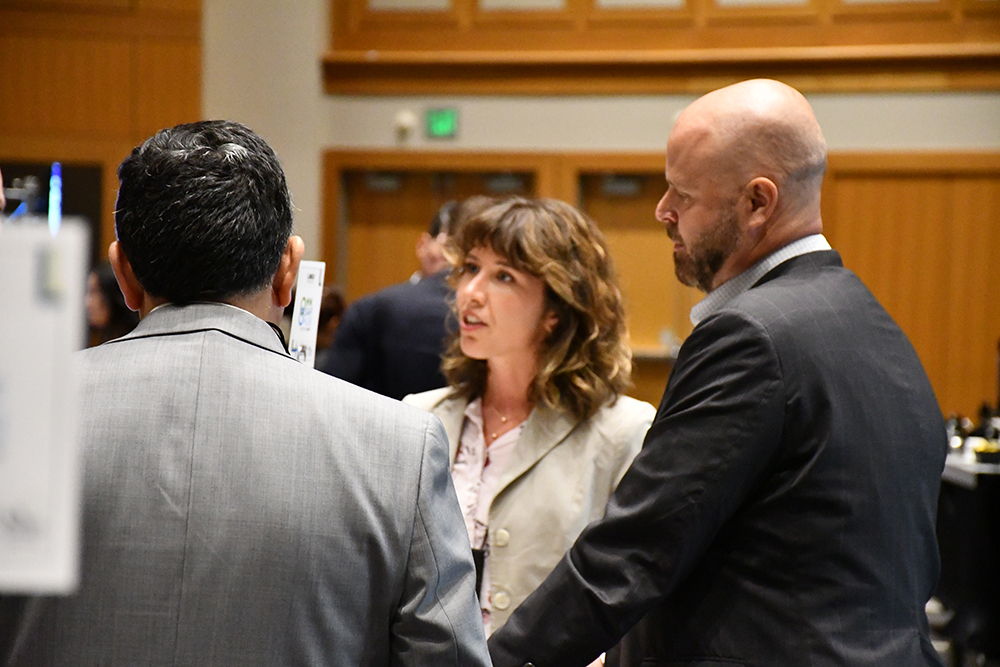What about water quality? 3 takeaways from our time at the SAF Conference

FMR Biofuels Policy Manager Meghan Anderson, left and FMR Water Program Director Trevor Russell, right, in conversation at the North American SAF Conference and Expo. (Photo by Chloe Piekkola & Danielle Piekarski / BBI International)
Hundreds of people from around the globe traveled to the Twin Cities last month for the North American Sustainable Aviation Fuel Conference and Expo. There, attendees discussed the future of SAF technology and policy. This conversation was driven primarily by industry experts, corporate decisionmakers, agribusiness representatives and biofuels researchers.
Also there? Friends of the Mississippi River.
Two members of FMR’s Water Program, myself and Trevor Russell, attended the conference. Our goal — when mingling with fellow attendees or participating in panels and presentations — was to share FMR’s perspective: That the industry needs to take a broad view of what it means to be “sustainable,” and account for the impact any new fuel might have on our air, land and water.
We were there, in short, to be the voice for the river.
Here are three things we discovered from our time at the conference.
1) Water and biodiversity aren’t currently top of mind
Throughout the conference, we heard scant mention of clean water, healthy soil or biodiversity. When we spoke with other conference attendees about FMR’s perspective on SAF, multiple people admitted they had never really considered how it could affect water quality.
That might seem surprising, but there’s a practical reason for this. The legal definition of SAF — the criteria the fuel needs to meet in order to qualify for tax credits (more on these below) — only references greenhouse gas emissions. If the fuel has less than half the carbon emissions of traditional jet fuel, then it qualifies as "sustainable aviation fuel."
But in our view, just being lower carbon is not the same thing as being sustainable. That’s why it’s important for advocates like FMR to keep pushing for broad definitions of sustainability in SAF, while also urging investments in the most environmentally friendly fuel sources we have, such as winter-hardy oilseeds.
2) Minnesota is likely to be a national hub of SAF activity
Over and over, we heard how Minnesota is expected to be a national leader in this new industry.
The state has the input materials (meaning, what the fuel is made out of) in its agricultural crops and forest products, a major airport with MSP, and a highly trained and educated workforce. Critically, there is also a state tax credit for producers of SAF. (In fact, the Star Tribune recently highlighted SAF as one of the "Midwestern ideas shaping the future.)
Under current conditions, however, SAF is still much more expensive than traditional jet fuel. In order for early adoption of SAF to make economic sense for airlines, they need both a federal boost and a state boost.
A federal credit does exist, though as we mentioned earlier, they’re based only on greenhouse gas emissions. That makes state policy a powerful lever for establishing stronger sustainability parameters.
Even if the federal government rolls back environmental protections, SAF companies are going to have to meet the more stringent state laws if they want to benefit from all the available incentives.
3) Now is the time to shape SAF's future
Right now, there are only a handful of SAF production facilities throughout the country, and the number of SAF-powered flights that have happened in the U.S. is quite small. (The Delta flight powered in part by winter camelina is one example.) Even the experts can’t agree on what they think the next five or 10 years will look like, because there are still so many unknowns.
SAF companies are waiting for more stability in state and federal policy before committing billions of dollars to building new production facilities. Policy is shaping the way this new industry rolls out, and how truly sustainable it will end up being.
How we'll build on what we learned
The North American SAF Conference allowed us to peek behind the curtain to hear what the industry decision-makers are saying. It’s clear they see Minnesota as an emerging leader in the SAF space, and that state policy will be influential in shaping what happens next.
Importantly, we also shared our message of clean water and healthy rivers directly with decisionmakers, researchers and leaders. We were really encouraged by the thoughtful questions and positive response from attendees.
But concrete public policy decisions and industry commitments are where the rubber meets the runway.
FMR will continue to advocate for clean water, soil health, habitat and pollinators in state and federal SAF conversations. By ensuring that our guiding principles form the backbone of SAF policy going forward, we will help deliver a SAF industry that is more than just low-carbon, but one that is on a flight path toward true sustainability.
